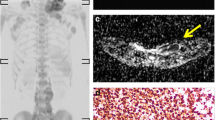Summary
The feasibility of diagnosing the malignancy and viability of intraparenchymal brain tumours using Gd-DTPA, enhanced and unenhanced T1-weighted MRIs was investigated. The relationship between the Gd-DTPA enhancement pattern, the growth fraction (GF) determined by using the anti-bromode-oxyuridine (BrdU) monoclonal antibody, the clinical condition, the proliferative potential and the change of Gd-DTPA enhancement over time was studied.
Forty-five patients with intracranial tumours were studied with the static method of Gd-DTPA MRI. The enhanced effect in Gd-DTPA MRIs was dependent on tumour-cell density, vascularization, necrosis, and dilatation of vascular lumen. Tumour-cells were observed in eighty-seven of eighty-nine specimens taken from areas with Gd-DTPA enhanced MRIs. Seventy-four percent of these specimens (64 of 87) showed a malignancy of more than 5% growth fraction. On the other hand, tumour cells were observed in twentyseven of fifty-six specimens taken from areas with Gd-DTPA unenhanced MRIs. Eighty-five percent of these specimens (23 of 27) showed a malignancy value of less than 5% GF. However, fifteen percent of these specimens showed values between 5 and 15% GF.
In the kinetic study of Gd-MRIs five patients who were in a clinically stable condition and one patient who had radionecrosis showed a constant pattern of enhancement or slightly increased enhancement 30 min after injection compared to 4 min after injection.
Therefore, GD-DTPA MRI can be used effectively in the diagnosis of tumour viability and malignancy after treatment.
Similar content being viewed by others
References
Brant-Zawadzki M, Norman D, Newton TH, Kelly WM, Kjos B, Mills CM, Dillon W, Sobel D, Crooks LE (1984) Magnetic resonance of the brain: the optimal screening technique. Radiology 152: 71–77
Brasch RC, Weinmann HJ, Wesbey GE (1984) Contrast-enhancement NMR imaging: animal studies using gadoliniumDTPA complex. AJR 142: 625–630
Carr DH, Brown J, Bydder GM, Weinmann HJ, Speck U, Thomas DJ, Young IR (1984) Intravenous chelated gadolinium as a contrast agent in NMR imaging of cerebral tumours. Lancet 1: 484–486
Carr DH, Brown J, Bydder GM, Steiner RE, Weinmann HJ, Speck U, Hall AS, Young IR (1984) Gadolinum-DTPA as a contrast agent in MRI: initial clinical experience in 20 patients. AJR 143: 215–224
Claussen C, Laniado M, Kazner E, Schörner W, Felix R (1985) Application of contrast agents in CT and MRI (NMR): their potential in imaging of brain tumors. Neuroradiology 27: 164–171
Claussen C, Laniado M, Schörner W, Niendorf HP, Weinmann HJ, Fiegler W, Felix R (1985) Gadolinium-DTPA in MR imaging of glio-blastomas and intracranial metastases. AJNR 6: 669–674
Earnest IV F, Kelly PJ, Scheithauer BW, Kall BA, Cascino TL, Ehman RL, Forbes GS, Axley PL (1988) Cerebral astrocytomas: the topathologic correlation of MR and CT contrast enhancement with stereotactic biopsy. Radiology 166: 823–827
Felix R, Schörner W, Laniado M, Niendorf HP, Claussen C, Fiegler W, Speck U (1985) Brain tumors: MR imaging with gadolinium-DTPA. Radiology 6: 855–862
Gado MH, Phelps ME, Coleman ER (1975) An extravascular component of contrast enhancement in cranial computed tomography. Radiology 117: 589–593
Graif M, Bydder GM, Steiner RE, Niendorf HP, Thomas DGT, Young IR (1985) Contrast-enhanced MR imaging of malignant brain tumors. AJNR 6: 855–862
Houdek PV, Landy HJ, Quencer RM, Sattin W, Poole CA, Green BA, Harman CA, Pisciotta V, Schwade JG (1988) MR characterization of brain and brain tumor response to radiotherapy. Int J Radiat Oncol Biol Phys 15: 213–218
Jinnouchi T, Shibata S, Fukushima M, Mori K (1988) Ultrastructure of capillary permeability in human brain tumor — part 6: metastatic brain tumor with brain edema. Neurol Surg (Tokyo) 16: 563–568
Johnson PC, Hunt SJ, Drayer BP (1989) Human cerebral gliomas: correlation of postmortem MR imaging and neuropathologic findings. Radiology 170: 211–217
Kelly PJ, Daumas-Duport C, Scheithauer BW, Kall BA, Kispert DB (1987) Stereotactic histologic correlations of computed tomography- and magnetic resonance imaging-defined abnormalities in patients with glial neoplasms. Mayo Clin Proc 62: 450–459
Laster DW, Ball MR, Moody DM, Witcofski RL, Kelly DL (1984) Results of magnetic resonance with cerebral glioma; comparison with computed tomography. Surg Neurol 22: 113–122
Long DM (1979) Capillary ultrastructure in human metastatic brain tumors. J Neurosurg 51: 53–58
McGinnis BD, Brady TJ, New PFJ, Buonanno FS, Pykett IL, De La Paz RL, Kistler JP, Taveras JM (1983) Nuclear magnetic resonance (NMR) imaging of tumors in the posterior fossa. J Comput Assist Tomogr 7: 575–584
Mori K, Kurisaka M, Moriki A, Sawada A (1991) Intracranial tumors. In: Mori K (ed) MRI of the central nervous system: a pathology atlas. Springer, Berlin Heidelberg, pp 43–109
Price AC, Runge VM, Allen JH, Partain CL, James AE (1986) Primary glioma: diagnosis with magnetic resonance imaging. CT 10: 325–334
Randell CP, Collins AG, Young IR, Haywood R, Thomas DJ, McDonnel MJ, Orr JS, Bydder GM, Steiner RE (1983) Nuclear magnetic resonance imaging of posterior fossa tumors. AJNR 4: 1027–1034
Runge V, Schorner W, Niendorf HP, Laniado M, Koehler D, Claussen C, Felix R, James AE (1985) Initial evaluation of gadolinium-DTPA for contrast-enhanced magnetic resonance imaging. Magn Reson Imaging 3: 27–35
Sage MR (1982) Blood-brain barrier: Phenomenon of increasing importance to the imaging clinician. AJNR 3: 127–138
Tokano S, Yoshii Y, Nose T (1991) Ultrastructure of glioma vessel: morphometric study for vascular permeability. Brain Nerve (Tokyo) 43: 49–56
Weinmann HJ, Brasch RC, Press WR, Wesbey GE (1984) Characteristics of gadolinium-DTPA complex: a potential NMR contrast agent. AJR 142: 619–624
Yoshii Y, Maki Y, Tsuboi K, Tomono Y, Nakagawa K, Hoshino T (1986) Estimation of growth fraction in human central nervous system tumors by bromodeoxyuridine. J Neurosurg 65: 653–659
Zimmerman RA, Bilaniuk LT, Goldberg HI, Grossman RI, Levine RS, Lynch R, Edelstein W, Bottomley P, Redington R (1984) Cerebral NMR imaging: early results with a 0.12T resistive system. AJNR 5: 1–7
Author information
Authors and Affiliations
Rights and permissions
About this article
Cite this article
Yoshii, Y., Komatsu, Y., Yamada, T. et al. Malignancy and viability of intraparenchymal brain tumours: Correlation between Gd-DTPA contrast MR Images and proliferative potentials. Acta neurochir 117, 187–194 (1992). https://doi.org/10.1007/BF01400619
Issue Date:
DOI: https://doi.org/10.1007/BF01400619




